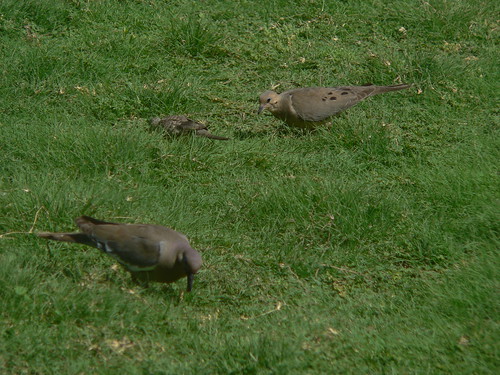- We wanted pretty flowers, if possible.
- We wanted native plants if possible.
- We needed a thornless vine
- We needed heat loving vines that would cover the arbor for the summer.
- We wanted a perennial vine to come back every year.
- We needed a drought tolerant vine in case we slacked on the watering.
Unlike the "other native", Cat's Claw (Macfadyena unguis-cati), Queens wreath is frost-tender and dies back to the ground every winter. It's a less aggressive grower and can be controlled with occasional pruning.
Except for the trees ... It goes from the arbor to the old orange tree and covers it like a hat. This doesn't appear to harm the tree, and the oranges ripen under the vine. We pull the vine out when the oranges are ripe.
 |
| Queen's Wreath Covering Orange Tree (the tree is the mound at the left) |
Are Bees a Problem?
Queen's Wreath attracts bees, dozens of honey bees and wild alkali bees - it's a great way to attract pollinators to your garden all summer long.Because it's growing on an arbor, the flowers are all "up there" and so are the bees. You can sit under the arbor and listen to the bees, but they stay with the flowers.
Self-Seeding
This is a prolific seed-producer. The quail and other seed-eating birds forage under the arbor most of the year, gorging on seeds. They don't find them all, and those that land in a moist spot will germinate.They pop up all over the yard, but they are easy to recognize and pull up.
 | |
| Volunteer Queen's Wreath Seedlings (after a summer of unusually heavy rains) |
Removing the Dead Vines
We need to remove the vines every year or they build up a heavy, ugly dead mess on the arbor. The stems tend to lie on top of an arbor instead of twining through the mesh. We left space between the top of the vertical mesh and the side of the top mesh to make vine removing easier, and there is a foot or so between the top mesh and the wall of the house.Removing the old vines in early winter is easy. Don't let them get dry and brittle.
- Trim off all dangling vines at the top and edges of the trellis or arbor.
- Roll up any mat of vines that is on top of an arbor and toss it in the compost heap. A rake works well to get the mat going.
You may need to clip a few stems, but Queen's Wreath is more of a sprawler than a clinging vine on a horizontal lattice or mesh. - If you have room, get behind the trellis and cut the stems that you can find passing behind the trellis.
- If the trellis is large, cut the stems to divide the growth into vertical sections 3 or 4 feet wide.
- Start pulling the vines down from the sunny side. I use a rake and pull from the top down, rolling the vines as I pull. This removes most of the growth.
- Cut the stems close to the roots.
- That's it until next year.
Read more!




